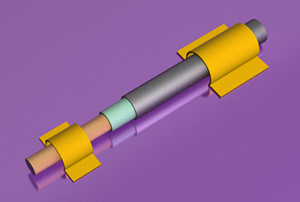Coaxial ‘nanocable’ could be big boon for energy storage
June 11, 2012

An artist's impression of Rice University's new coaxial nanocable, which is about a thousand times thinner than a human hair (credit: Rice University)
Researchers at Rice University have created a tiny coaxial cable only 100 nanometers wide with higher capacitance than previously reported microcapacitors.
The nanocable,produced with techniques pioneered in the nascent graphene research field, could be used to build next-generation energy-storage systems.
It could also find use in wiring up components of lab-on-a-chip processors.
The tiny coaxial cable is similar in makeup to the ones that carry cable television signals into millions of homes and offices. The heart of the cable is a solid copper wire that is surrounded by a thin sheath of insulating copper oxide. A third layer, another conductor, surrounds that. In the case of TV cables, the third layer is copper again, but in the nanocable it is a thin layer of carbon measuring just a few atoms thick.
This three-layer, metal-insulator-metal structure can also be used to build energy-storage devices called capacitors.
Background: capacitors
Unlike batteries, which rely on chemical reactions to both store and supply electricity, capacitors use electrical fields. A capacitor contains two electrical conductors, one negative and the other positive, that are separated by thin layer of insulation. Separating the oppositely charged conductors creates an electrical potential, and that potential increases as the separated charges increase and as the distance between them — occupied by the insulating layer — decreases. The proportion between the charge density and the separating distance is known as capacitance, and it’s the standard measure of efficiency of a capacitor.
The study reports that the capacitance of the nanocable is at least 10 times greater than what would be predicted with classical electrostatics — up to 143 microfarads per centimeter squared, better than the best previous results from microcapacitors.
“The increase is most likely due to quantum effects that arise because of the small size of the cable,” said study co-author Pulickel Ajayan, Rice’s Benjamin M. and Mary Greenwood Anderson Professor of Mechanical Engineering and Materials Science.
Lou said it may be possible to build a large-scale energy-storage device by arranging millions of the tiny nanocables side by side in large arrays.
“The nanoscale cable might also be used as a transmission line for radio frequency signals at the nanoscale,” Liu said. “This could be useful as a fundamental building block in micro- and nano-sized electromechanical systems like lab-on-a-chip devices.”
The research was funded by the National Science Foundation, Rice University, the Office of Naval Research, the Welch Foundation, the Center for Exotic NanoCarbons at Shinshu University and the Japan Regional Innovation Strategy Program by the Excellence.
Co-authors include Lou, Ajayan, Liu, Yongjie Zhan, Gang Shi, Lulu Ma, Wei Gao and Robert Vajtai, all of Rice University; Pradeep Sharma and Mohamed Gharbi of the University of Houston; Simona Moldovan and Florian Banhart, both of Institut de Physique et Chimie des Matériaux in Strasbourg, France; Li Song of Shinshu University in Nagano, Japan; and Jiaqi Huang, formerly of Rice and currently at Tsinghua University in Beijing.
Ref.: Zheng Liu et al., Anomalous high capacitance in a coaxial single nanowire capacitor, Nature Communications, 2012, DOI: 10.1038/ncomms1833